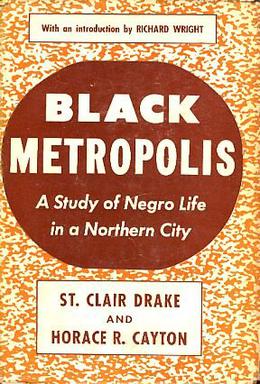Black Metropolis facts for kids
 |
|
| Authors | St Clair Drake, and Horace Cayton |
|---|---|
| Country | United States |
| Genre | Non-fiction |
| Publisher | Harcourt, Brace and Company |
|
Publication date
|
1945 |
| Pages | 809 |
| OCLC | 186494767 |
| Followed by | updated and expanded editions |
Black Metropolis: A Study of Negro Life in a Northern City is an important book about the lives of African Americans in cities. It was written by St. Clair Drake and Horace R. Cayton, Jr.. The book was first published in 1945. Later versions added information from the 1950s and 1960s.
The authors did a lot of research in Chicago. This research was part of a big government program. Experts say Black Metropolis is a very important book. It helps us understand African American history, culture, and city life.
Contents
What the Book is About
The book starts with an introduction by the famous writer Richard Wright. He talks about how the book's ideas connect to his own stories. Drake and Cayton then give a general overview of the "Black Metropolis."
Early History in Chicago
The first part of the book tells the history of African Americans in Chicago. It covers the early years of the Great Migration. This was a time when millions of African Americans moved. They left the Southern United States for cities in the North.
Life in the Black Metropolis
The book then looks at how the separate Black Metropolis community was formed. It also shows how this community connected with the rest of Chicago. Chapters explore topics like "Breaking the Job Ceiling." This means finding better job opportunities. Another chapter is "Black Workers and the New Unions." This looks at how Black workers joined labor unions. "Democracy and Political Expediency" explores how the community gained power.
The book also gives a detailed picture of daily life. Chapters include "The Power of the Press and the Pulpit." This shows the influence of newspapers and churches. "Negro Business" looks at businesses owned by Black people. There are also chapters about the different social classes. These include the upper, middle, and lower classes.
The authors found five main things that mattered to everyone in the community:
- Staying alive
- Having a good time
- Praising God
- Getting ahead
- Advancing the race (helping their community move forward)
The last part of the book has a note from a professor named W. Lloyd Warner. He explains how the research for the book was done.
How the Book Was Made
The idea for Black Metropolis came from a research project. Professor Warner started it at the University of Chicago. Horace Cayton helped him. Between 1935 and 1940, many people worked on the project. Twenty graduate students, including St. Clair Drake, were main researchers. Up to 200 people helped with gathering information and typing.
Cayton knew a lot about the wealthy and respected Black families. Drake learned about different community groups. He also studied working-class and lower-class people.
After the project, Warner thought it could be a book. Cayton believed a commercial publisher would reach more readers. Drake wrote most of the chapters. Cayton wrote the rest. Warner, Cayton, and Drake also reviewed and edited the book. The publisher, Harcourt, Brace and Company, wanted Richard Wright to write the introduction. Cayton knew Wright and was able to get him to do it.
Later versions of the book were expanded by Drake and Cayton. These came out in the 1950s and 1960s. The University of Chicago Press reissued the book in 1993 and 2015.
What People Thought of the Book
Some people have shared their thoughts on Black Metropolis.
Aimee Cox studied a group of Black girls in Detroit in 2015. She noted that Black Metropolis started a trend. This trend in city studies often focused on the success of Black men. It sometimes left out the experiences of Black women. She also felt that the idea of "success" in the book was mainly about money and social class.
James N. Gregory wrote about the book in 2007. He said the book focused a lot on how Black people were kept separate. He also felt it sometimes made it seem like the Black community had more problems than successes. Gregory pointed out that "Black Metropolis" used to be a proud term. But he felt the book made it seem more about the challenges of city life for Black people.
Awards
- 1946: Anisfield-Wolf Book Award in nonfiction.

